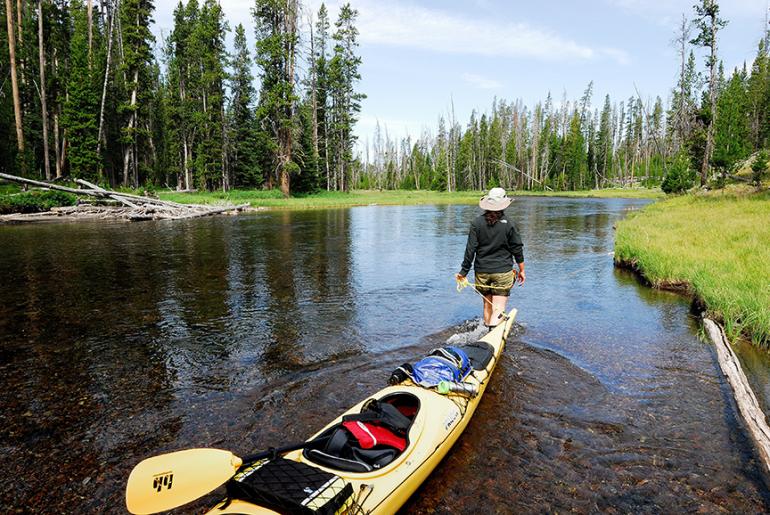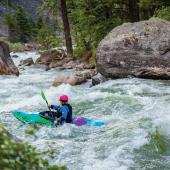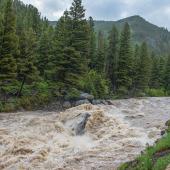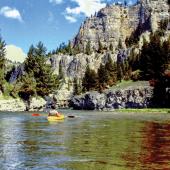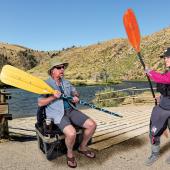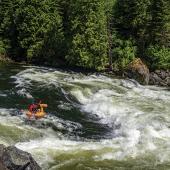Paddler's Paradise
A solo adventure to Shoshone Lake
After an unusually bad week working at one of Yellowstone Park’s restaurants, I needed an escape to the backcountry. I’d been fishing frequently at Lewis Lake, but now, by the middle of summer, the trout had retreated into the depths, far out of reach from shore. After consulting with the Bridge Bay Ranger Station, I developed a plan to venture out to Shoshone Lake. Shoshone Lake is the second largest lake in the Park, the largest backcountry lake in the Lower 48, and is relatively untouched due to its remote location. Perfect.
My plan was to journey up the Lewis Channel to one of the backcountry spots on the lake, the majority of which were reserved for canoes or kayaks. After promising to take excellent care of my buddy’s kayak (plus handing over a goodwill six-pack of microbrews), I had my transportation.
As soon as the weekend hit, I headed to my tiny dorm and set out my gear. I had very little on-water kayaking experience, let alone packing one for an overnight trip. Using my best Tetris skills, I managed to squeeze my gear into the boat’s tiny “waterproof” bulkhead. After an early start and a 30-mile drive, I was unloading the kayak at the Lewis Lake dock. With clear skies and clear waters, I headed out towards the channel.
Not 15 minutes into my journey, the wind picked up. Two-foot waves felt like whitecaps as they crashed into the tiny boat. I paddled on, stroking across Lewis as fast as I possibly could. After a solid hour of what felt like life-or-death battling, I bobbed into the safety of the channel.
The calm of the Lewis Channel allowed me to tie on my favorite lure, cast out, and continue paddling. The water was completely still and I could see all the way to the bottom. I didn't see a single fish, but the tranquility was everything I had desired.
After squeezing past several downed trees and portaging my boat around another, I heard running water ahead. The water became shallower and faster. I fought the current for 15 minutes, advancing maybe 100 yards. I needed a new approach. I tied a rope to the fore end of the boat and dragged it for several miles, until the channel gave way to my first view of the Shoshone River. The river was glorious, but the winds were back, and with them, even larger waves. I’d come too far to turn back—I pushed on.
The winds died down as I slid into my campsite, relieved to finally be on dry land. I pulled out my gear—the majority of it damp—and laid it out to dry while I headed back to the water to catch dinner.
The fishing was unmatched. Every other cast returned a lake trout. I kept the first and released the rest, bringing in 10-15 trout before the sun began to set. I headed back to set up camp before dark.
My camp was right off the beach with no one for miles—exactly as I’d hoped. I quickly filleted my trout and made a nice fish pasta—nothing in the world compares to a freshly harvested fish. Exhausted from the day’s journey, I cleaned up and headed right to my hammock.
The reds and oranges of the sunrise woke me the following morning. After a quick dip in the lake, I packed up and headed back towards civilization, stopping often to soak in the views and drop a line in the water. I caught five more lake trout, much to the chagrin of the bald eagles soaring overhead.
Near the end of my aquatic adventure, I inadvertently came too close to an otter den, which three sleek adult otters quickly brought to my attention. They barked sharply and swam around my boat, warning me away from their home. Otters are rare in the Park, but as I slowly floated away, it seemed a just ending to another Yellowstone exploration.
If You Go
Regulations
A YNP boating permit is required for any vessel brought into the Park. You’ll also need a fishing permit—state-issued licenses do not apply in the Park—and a backcountry permit if you plan to camp. Motorized vessels are allowed on Lewis Lake, but are prohibited on Shoshone Lake. To learn more about boating and fishing regulations within the Park and where to obtain permits, check out nps.gov/yell.
When to Go
Shoshone Lake is the largest backcountry lake in the Lower 48 and can produce extreme conditions in any season. Lewis and Shoshone lakes usually lose their ice by the second or third week in June, but late summer (August and September) is the safest, most comfortable time to paddle.
Safety
Over 100 people have lost their lives in the Park’s frigid lakes and streams. Water temperatures on Lewis and Shoshone lakes are barely above freezing in June, rising into the low 60s by late summer. Unless a person can get out of the water and get warm quickly, survival time is minimal, even while wearing a life vest. High winds are an almost daily occurrence and create challenging and hazardous conditions, including waves up to five feet tall. Avoid open-water crossings in the afternoon. Travel early in the morning or late afternoon for easier and safer conditions.


